* (restored)
—-
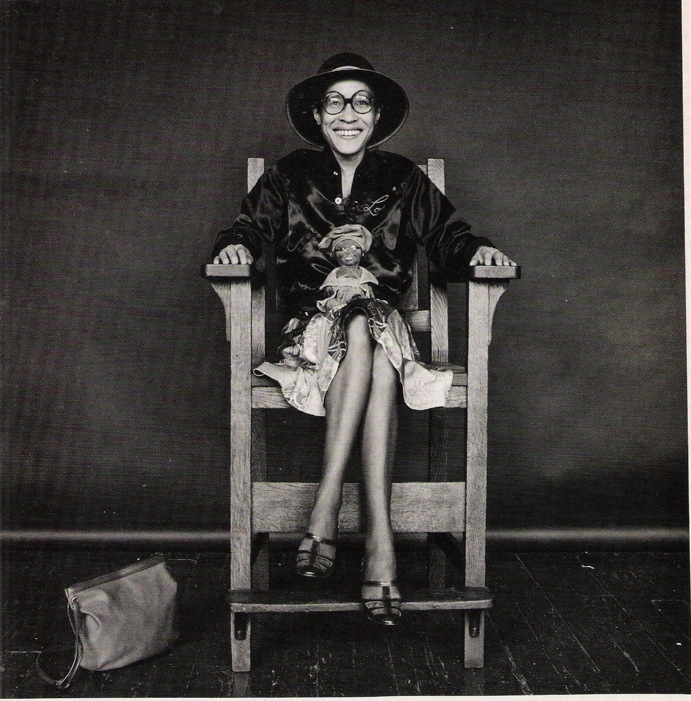
(photo: Dorothy Dean’s portrait by Robert Mapplethorpe)
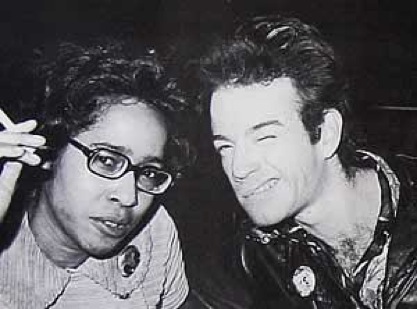
(photo: Dorothy Dean and Jackie Curtis)
Let’s begin at the end, shall we?
—-“Dorothy Dean, a former editor for The New Yorker and for such publishers as Times Books and Harry N. Abrams, died of cancer Friday at the Hospice of St. John in Denver. She was 54 years old and lived in Boulder, Colo.
—-Ms. Dean had also held editorial positions at Vogue magazine and at Harper & Row. From 1963 to 1964, she was a member of The New Yorker’s research department – then called the fact-checking department. At her death, she was a proofreader for The Daily Camera newspaper, published in Boulder.
—-Ms. Dean was born in White Plains. She was a graduate of Radcliffe College, and earned a master’s degree in fine arts at Harvard University. She also studied art history on a Fulbright scholarship in Amsterdam.”
As these things go, fairly accurate. But not accurate enough for Dorothy, the ultimate “stickler for details.” So let’s turn the floor over to my long-time saddle pal Bill Reed who writes of her in his matchless memoir Early Plastic (o.o.p., but available on eBay):
The following definition of the genus fag hag (you won’t find the term in Webster’s) appears in The Queen’s Vernacular: A Gay Lexicon, by Bruce Rogers:
—-“Some are plain janes who prefer the honest affection of homoerotic boy friends; others are on a determined crusade to show gay boys that normal coitus is not to be overlooked. A few are simply women in love with homosexual men; others discover to their chagrin that their male friends are charming but not interested sexually.”
—-All of which-and much more. except for the chagrin part-was true of my friend Dorothy Dean. The Mother of All Fag-Hags, she felt the term had an ugly ring to it, and much preferred “Fruit Fly.” I didn’t get to know her until some time after her mid-1950s glory years during which she was the Queen Bee of a Harvard set that operated out of the Casablanca bar (where Edie Sedgewick later came to shine). And where the men that she hung with —none of whom had any notion that there was anything coming down the line called gay lib—looked to her as a kind of ultimate arbiter of style, attitude and taste. She was an outrageous woman who would say things that no one they had ever met before would dare utter. She would tell people to their face exactly what she thought of them and continued to play this role later on in a number of different contexts. It was almost inevitable that Dorothy would become part of Andy Warhol’s Factory circle, where it was demanded that people be outrageous and try to top one another. But that scene had pretty much disappeared by the time my boyfriend David and I met her in the Seventies. Her breakup with longtime closest friend Arthur Loeb was indicative of a lot of dissolutions and changes that were going on within the social scene. Gay militancy had to some degree turned the fag-hag into a symbol of the past, both in its traditional cheer-leader style and even in Dorothy’s overwhelming she-who-must-be-obeyed approach. In addition, unlike your garden variety fag-hag who fears sex, Dorothy wanted to get it on with her boys-she wasn’t afraid of anything-and was equally inclined toward heterosexual inamorata.
—-Complex to a fault, Dorothy was the sweetest, brightest, and most frightening woman I have ever known. I met her in 1970 while working at a bookstore owned by her friend Arthur, the inspiration for the Dudley Moore movie of the same name (or so it has always seemed to me) and a member of a prominent New York family long perched in the more vertiginous heights of New York’s 400. In exchange for their son’s pledge to put aside his legendarily dissolute lifestyle, Arthur was being backed to the hilt by his parents in this literary emporium that advertised itself as “a carriage trade” operation in the classified ad that I answered for a job. I was on staff when the place opened, and although Dorothy wasn’t an employee, she was so omnipresent a fixture that she seemed like staff. My boyfriend David was dazzled when he found out she hung out at the place.
—-Working for Arthur was not at all like work. A past master of the zippy comeback department, one day an East Side matron came into the store and with a totally straight face asked him what might he suggest for “a man who has everything and is going on safari.” Without missing a beat, he replied: “Have you considered giving him Deborah Kerr?” An avid reader of the New York Times, who always first read the bridge column and obituaries each day before getting on to the day’s less important news, Arthur said that his memoirs were going to be called (in a play on the Rocky Graziano autobiography), Somebody Down There Likes Me. I was surely as good an “audience” as Arthur was ever likely to get.
—-While she may have been black and a woman, in the final analysis, she wasn’t black and she wasn’t a woman: she was Dorothy Dean. Slight, ferret-like, and possessing coffee-with-cream skin, Dorothy wore horn-rimmed coke bottle lens glasses, usually dressed in a simple, tasteful shift dress; and was, without question, New York’s most incurable diseuse. Nearly every time I was with Dorothy, she happened to be drinking; she would invariably ask me the same question: “Did I ever tell you about the time I once danced the ‘Tennessee Waltz’ in Tennessee with Tennessee Williams?” (Which was true.) She claimed that it was one of her proudest accomplishments in life. I don’t think she was joking.
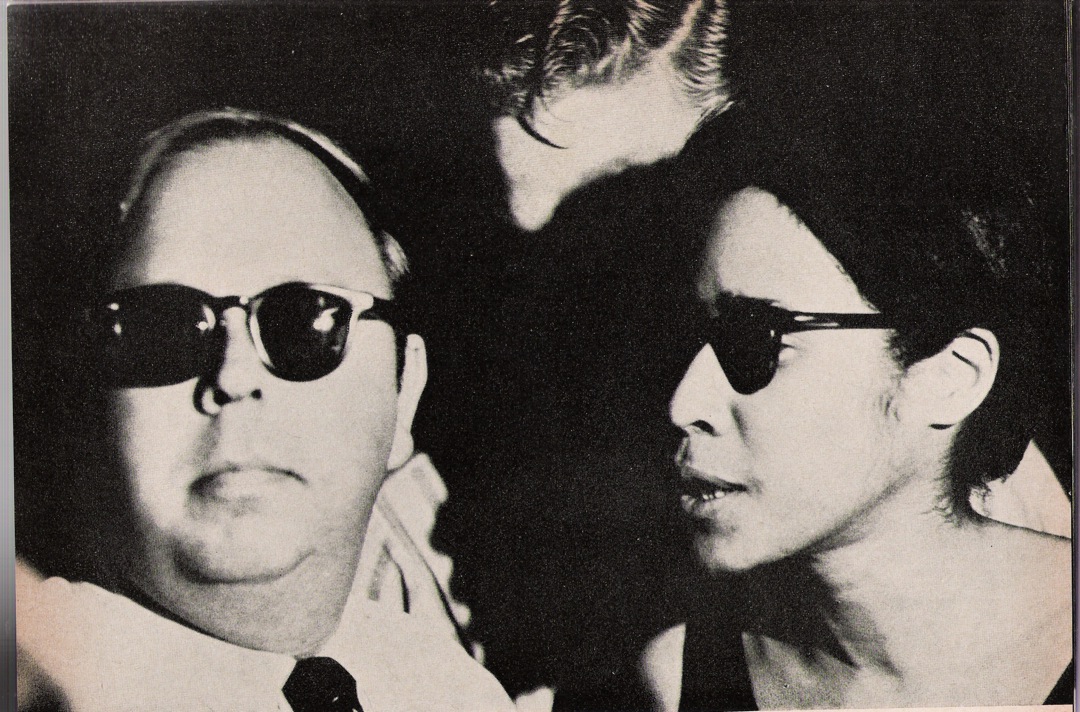
(photo: Henry Geldzahler and Dorothy Dean)
In 1995 the New Yorker ran a lengthy profile of Dorothy, entitled “Friends of Dorothy,” by which time she had been dead for nearly a decade. Fifteen years earlier the Soho Weekly News had run a picture of her at a party with “living legend” underneath it, and the New York Times contained a brief obit of her in 1987 when she died; but until the New Yorker, that was just about the only public acknowledgement of the unique part Dorothy had played in at least a half-dozen overlapping social and professional “scenes” in New York in the Sixties.
—-Hilton Als wrote in the New Yorker profile [which can be found in his collection of essays called The Women } that years after her passing, people are still “dining out on Dorothy stories.” One of the many tales not included by Als was related to me by Dorothy herself shortly after I met her. In her usual nasal drawl, which bore a remarkable resemblance to Mae West if she had gone to Radcliffe (which in fact Dorothy had), Dorothy asked me, “Have you ever heard of this person, Kris Kristofferson?” An odd question, because of course I had heard of the hyphenate performer who had just crossed over from recording artist to actor in a series of mildly interesting films such as Cisco Pike and Pat Garrett and Billy the Kid. Dorothy then went on to tell me about a brief and intense relationship (were there any other kind for Dorothy?) with the entertainer that had taken place in Italy fifteen years earlier. She was on a Fulbright and Kristofferson was (hard to believe) a Rhodes scholar, fully one hundred eighty degrees away from the public shit-kicker image he began cultivating in the 1960’s.When it came to pass that Kristofferson resurfaced in this entirely unrecognizable form of movie star-country singer, Dorothy sprang into action. She sent him a letter excoriating him for all the cultural criminalism he was wreaking (“Jesus Was a Capricorn” has to be the all time worst song title ever, she opined) on records and in films. Her missive to him was minus a trace of for-old-times- sake sentimentalism, but instead was a request—more like a pronunciamento—that Kristofferson tithe a reparative ten percent of his considerable earnings to the New York Public Library. She never received a reply.
—-Growing up, Dorothy was felt to be exceptional. Born in 1932 to Reverend Elmer Wendell Dean and his wife, Dorothy was the first black valedictorian of White Plains High School. In 1950, she entered the gates of Radcliffe to become one of the few African-Americans on its campus. Four years later she graduated there with a bachelor’s degree, with honors in philosophy, and then went on for a masters at Harvard where at some point, Dorothy later told me, she had become pregnant by a wealthy student there. The boy, fearful of the consequences of his blue-blooded parents learning that he had impregnated a girl-and an African-American at that!-washed his hands entirely of the matter. Dorothy, even then possessing a fair share of temerity, proceeded to blow the whistle on the cad to his fraternity brothers. Forthwith they, in an act of honor, broke into the boy’s dorm room, stole a small Matisse from his wall, gave it to Dorothy, who sold it for enough to pay for an abortion-and then some. In 1956 Dorothy became pregnant once again; this time, though, she went full term before giving the child up for adoption. Some people believed the father was a Dutch student she met while on a Fulbright; others thought him a certain M.I.T professor.
—-In 1963 Dorothy, her extensive formal studies finally concluded, arrived in New York, where she was immediately taken up by a set of sad young men and bright young things, many of them relocated from Cambridge. Once again, they became seminal to her reputation as the mother of all fruit flies. Now Dorothy also found herself becoming acquainted with the world of Sixties New York debs, druggies and drag queens.
—-Some believed that Dorothy harbored toward fellow blacks an aversion bordering on loathing, as perhaps evidenced by the fact that she ofttimes referred to James Baldwin as Martin Luther Queen, and was not at all adverse to using “watermelon” and “jigaboo” rhetoric when writing or talking about blacks. While this might indicate that even Dorothy found it hard to avoid the tradition of red, white and blue racial self-loathing, it never seemed to bother her that my friend David was African-American.
—-A stickler for grammar, even in the most casual of conversations, one nearly always felt the presence of a giant red pen in Dorothy’s hand ready to strike you down and mark you up for incorrect usage. Thus, it isn’t surprising that her passion for lingual concision led to one job after another in various copy editing and proofreading capacities at such publications as Vogue, Show, the New Yorker and Essence, “the magazine that proves black is pathetic,” she once said. She was fired from the latter after suggesting that the magazine run a picture on its cover of her friend Andy Warhol in blackface.
—-As with most people of slight build, it didn’t take much in the way of intake to get Dorothy drunk. Like my mother, one drink and Dorothy was well on her way to Blotto City. One evening she came to have dinner with David and me at our apartment on West 85th Street and was as charming as ever. . .at first. But it only took a couple of glasses of wine to put her in her cups. She ended up staying the night, and was more or less a royal pain-waking David and me up, tickling us, crashing crockery to the floor, etc., until finally passing out in the wee small hours. A couple of days later we received from her a pluperfect “Miss Finch’s Day School for Young Ladies” bread and butter letter thanking us for our hospitality, except for the postscript in which she profusely apologized for her besotted behavior. We were scarcely the first to be sent such a note. These thank you/apology missives, we later learned, were a part of Dorothy’s dinner going modus operandi.
—-Dorothy often referred to herself as the Black Barbarella, but reminded me more of Dennis the Menace’s prissy friend Margaret, who wanted your friendship and was willing to lose it at any cost. In the last analysis, she was an unreconstructed hipster, cut from much the same cloth as those I had known at Stanley’s Bar on the Lower East Side.
—-At one point Dorothy was hired to guard the portals of a somewhat trendier, slightly more uptown version of Stanley’s, known as Max’s Kansas City. It was home away from home to the conglomeration of failed hippies, artist manques and Euro-trash who satellited around Andy Warhol, and had the back room of the trendy spot pretty much all to themselves. No bigger than a minute, Dorothy Dean may have been the only bouncer ever hired strictly for the brute force of her vicious tongue.
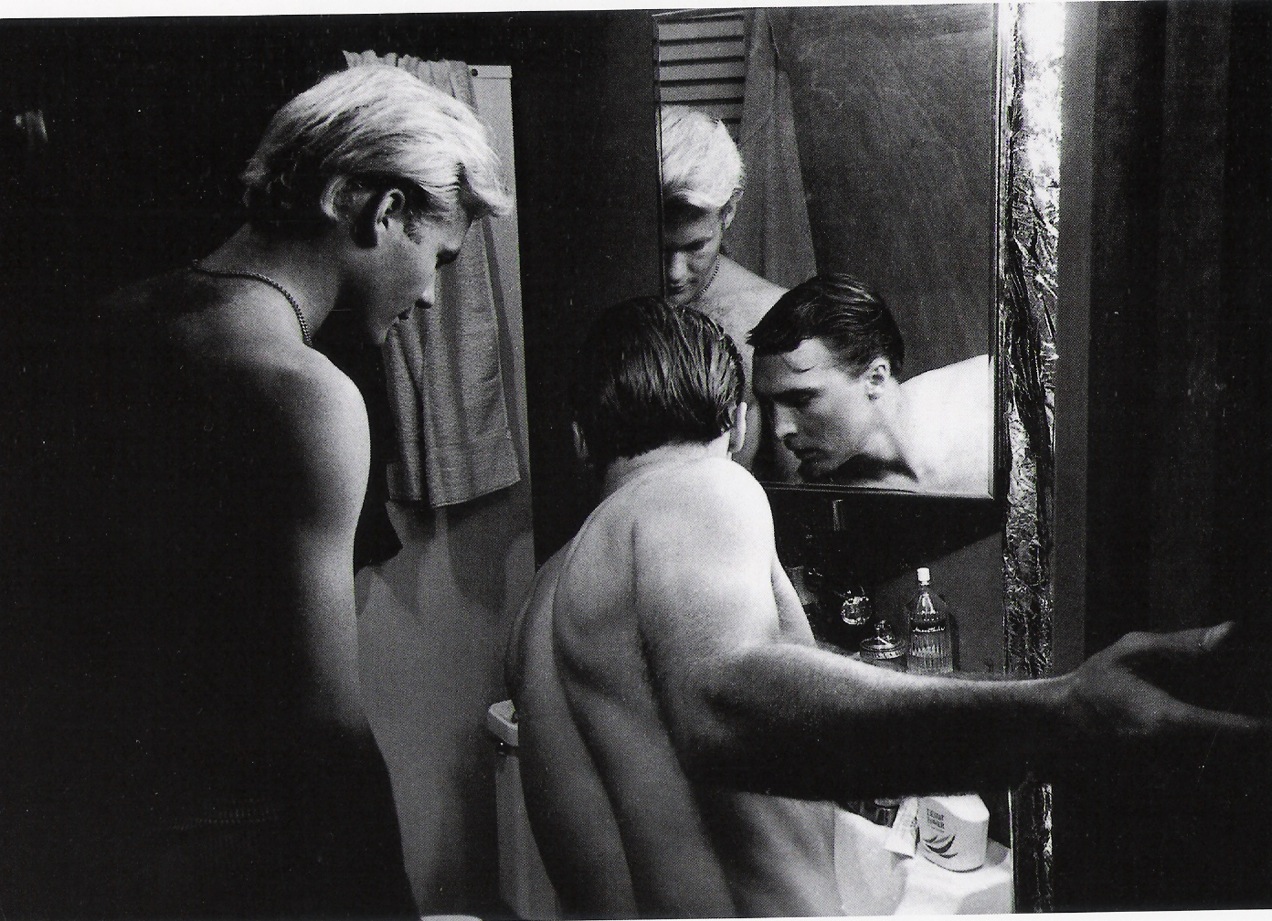
(photo: The Sugar Plum Fairy (Joe Campbell) in My Hustler)
Be they straight or gay, Dorothy specifically had a “thing” for men with high cheekbones-in fact, she could be said to have elevated such a taste to the veritable level of sexual fetish. Her small Greenwich Village apartment was dominated with the famous Personality Poster of a very handsome, young and shirtless Herb Alpert who, say what you will about his corny music, had cheekbones like the White Cliffs of Dover! The same could be said of Clint Eastwood – another Dorothy passion. But the most devastating cheekbones of all belonged to one Joe Campbell, aka the Sugar Plum Fairy who, despite that moniker, was one legendarily tough little number. A co-star of Warhol’s classic comedy of manners, My Hustler, where he does his butcher-than-thou act to the max, this demi-mondaine was the lover of Harvey Milk, when the gay-politico- martyr-to-be was a closeted New York investment banker. He was also, along with Dorothy, a major “character” in Warhol’s taped “novel” A. I never met him, but my friend David certainly did. One afternoon in the basement of the Museum of Modem Art, while waiting for the doors of the film auditorium to open for a screening of something foreign and obscure, Joe spied David (sitting demurely, leafing through a copy of the latest “Sight and Sound”), and made his move. Terrified by Joe’s ability to move from a quick hello to an even quicker “let’s go back to my apartment,” David politely declined. “You turned down The Plum!,” a horrified Dorothy exclaimed when told of the incident many years later, “How could you?” Still for all his cheekboned perfection, Joe didn’t mean as much to Dorothy as her longtime running buddy Arthur did.
—-For a couple who were not married or even sexually involved, Dorothy and Arthur were an extraordinarily famous twosome. For years they had been nearly inseparable, with their main base of operations being Andy Warhol’s inner circle; one so inner that it is unknown to all but the most well-versed in Warholian lore. In A Dorothy appears as “Dodo Mae Doom,” she’s “Gwen,” a central character in Lynne Tillman’s Cast in Doubt (Tillman also features Dorothy stories in her book about the Warhol Factory The Velvet Years); and in James McCourt’s novel, Time Remaining, she appears as herself. Additionally, she pops up as nearly herself in several Andy Warhol films, including My Hustler (a very funny walk-on in the last reel), the original cut of Chelsea Girls (her section, “Afternoon” also featured Arthur, was shot in his apartment, and somehow disappeared during the second week of the films’ initial run), and in several sequences of Warhol’s legendary 25-hour-long Four Stars. The truly Dorothy dedicated can also find her playing a secretary in Jean-Claude Van ltalie’s gay porn classic American Cream.
—-In what Dorothy later described to me as “an act of systematic sobriety,” Arthur began-shortly after opening up the rehabilitationaI therapy/retail establishment where I worked and initially met Dorothy-to slowly chop away from his life all the people and things that he felt had reduced him to his previous, pitiable alcoholic estate. Almost like he was going down a list ticking off people, influences and controlled substances one by one. Just like a tornado which first appears to be miles in front of you and then suddenly is right on top of you, Dorothy never saw her own de-annexation coming. Finally one day Arthur came to her on his mental list and, without provocation, never spoke to her again: she would come in the store, he would leave; she would phone, he would hang up. Previously thought to be as invulnerable as Margaret Thatcher crossed with Loretta Young, suddenly Dorothy was a bundle of raw nerve ends-crying like a seventh grader who had just been terminally dis-ed by someone they had been friends with for a lifetime. Dorothy begged me to intervene with Arthur, but I wouldn’t have known how to even begin, and so I spent a lot of supportive time with her in her cups, while she just sobbed over and over again. . .”Why?” She was willing to do anything, even Alcoholics Anonymous, to regain Arthur’s friendship. But the door of fraternity was inexorably slammed shut. Here was the toughest woman in New York, and she had met her Waterloo. I have never known one human being be so hurt by another’s actions. And yes, as far as I know, the once notoriously wet Arthur is still sober twenty-five years later-a feat comparable to crossing the Rubicon. Shortly after Arthur fired Dorothy from his life, he also gave me, without explanation, my walking papers as an employee. I never saw him after that.
—-Dorothy was a long time member of the National Board of Review, the fuddy duddy quasi-official film board. This was indicative of her station in life as a frustrated film critic. She once told me an hilarious story about viewing, in her capacity as a NBR member, a particularly racy foreign film, Louis Malle’s Les Amants, in which the heroine and hero are both horizontal in bed nearly naked. When the former, going down on her lover, disappeared frame left, the woman next to her began to question hysterically, “Where did she go? Where did she go?” “To the bathroom,” Dorothy answered. Which seemed to have satisfied her fellow Board member.
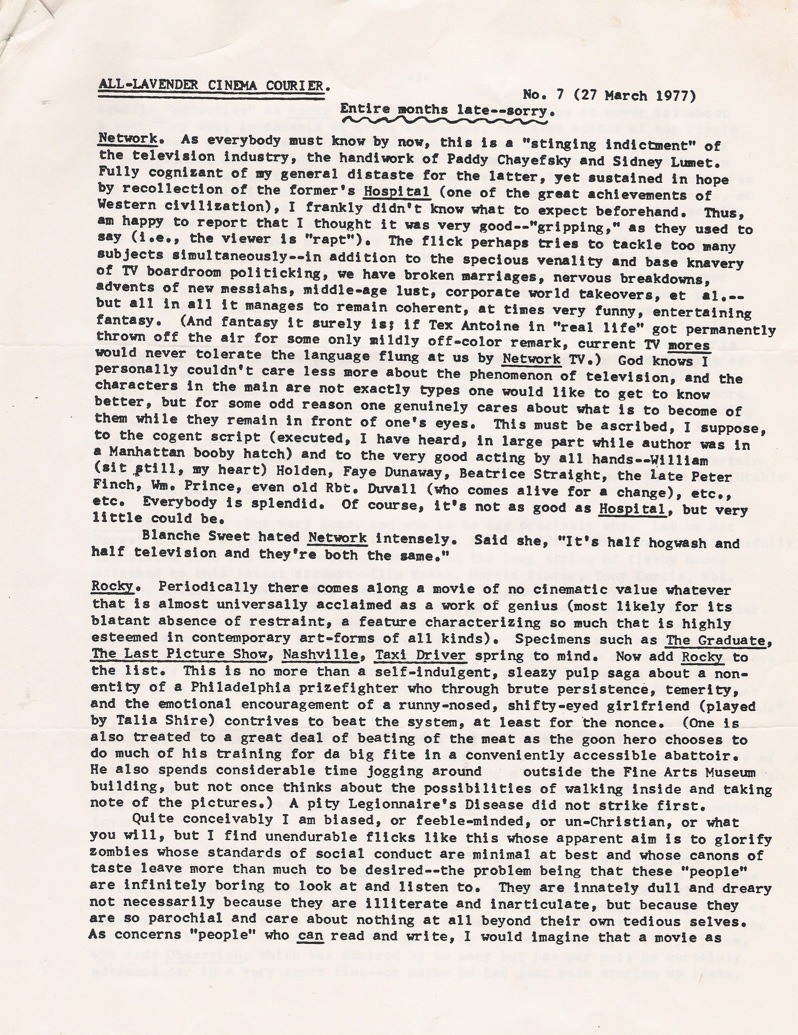
(photo: All Lavendar Courier cover)
Dorothy, David and I had dinner the last night before he and I moved from New York to California in 1975; but it was not the final time I heard from the “Queen of Spades” as she sometimes called herself-along with the “Spade of Queens.” In what was clearly a working out of her long suppressed desire to be a film reviewer. Dorothy began putting out her own rather wild manuscript reply to the NBR’s long-running. But exceeding unimaginative publication Films in Review. Calling her publication the All-Lavender Cinema Courier. we began receiving copies of it shortly after moving to California, starting in July 1976 with issue number 3. Knowing Dorothy there may not have even been a 1 or 2, or else these might have been issued sometime during the Sixties. Enclosed with the issue was a form letter which was a request for money to keep her venture going. In it she wrote:
—-“We are all aware, I fear, that most practicing movie critics are pragmatically useless. They consistently lose sight of the point that the cinema’s prime function is entertainment; they are misleading, pretentious. and needlessly longwinded.” In the letter Dorothy never explains how she intends to avoid such pitfalls. but in the “Courier” proper she cuts right to the chase, heaping praise upon well-crafted commercial crowd pleasers and damning almost all other films, domestic or otherwise, which fell outside these rigidly constructed critical boundaries. Much of the “Courier” is Wonderful Stuff. Here is one entry chosen at random:
—-“The Last Tycoon. Not very good and who is to say precisely why. Let us not forget that F. Scott Fitzgerald, it is said, by definition can never be successfully translated into the movie medium. But given the long string of flash names attached to this latest attempt—Elia Kazan. Harold Pinter. Tony Curtis. Rbl De Niro. Robert Mitchum (gone, sadly to fat). Jeanne Moreau. Jack Nicholson, Donald Pleasence. Ray Milland. Dana Andrews, etc.—one had hoped for much better. However. all is most humdrum and drab. inane and vacant, constituting a movie without a personality. The dialogue comes mostly from FSF. as I remember. except of course for the pitifully false ending; and so it is really difficult to imagine how Harold Pinter. as has been claimed. consumed an entire year in ‘crafting’ a script from what survived of the original MS. It is disheartening to learn that someone brilliant enough to describe scotch whiskey as the ‘great malt that wounds’ (Pinter. No Man’s Land) could fail so markedly at patching together extant Fitzgerald. Perhaps if some of the planes and trains and what have you in the original had been retained, the results would have been perkier. The spectacle of De Niro stalking about in expectation of conveying a commanding presence as the high panjandrum of a big-time Hollywood movie studio is ludicrous; Robert Allen could easily get away with this kind of thing but not the aforementioned mealy-mouthed invertebrate.”
—-Doubtlessly Dorothy’s ad hominem characterization of DiNiro was based on actual experience, for she was definitely not of the school that believed that revenge is a dish best served cold, as evidenced by her remarks re: the film The Other Side of Midnight in issue no. 8 (14 July 1977) of the “Courier”:
—-“[Marie-France Pisier] is eventually in a most enviable position, indeed as regards implementing the revenge of one’s dreams- the very best kind, whereby the revengee is made to hopelessly writhe and squirm and agonize, fully cognizant of the source of his suffering.”
—-As for the film itself, Dorothy deemed it, “Quality trash on a high level, and a stunning paean to [you guessed it] revenge.”
—-Below the “Tycoon” review is one for Brian De Palma’s Carrie (a wish fulfillment fantasy for Dorothy if ever there was one!) which begins: DO NOT MISS!!!! Eight to ten such squibs were included in each issue of the “Courier” which, at the bottom of number three, Dorothy scrawled a personal note to me:
—-“I am dismayed at myself that it’s taken so long to get the ALCC going again. Will answer your letter properly in a few days (I hope)—glad to hear you have settled in, as it were.”
—-But Dorothy never did answer my letter, and then after issue number 8 of the “Courier” dated July 14, 1977, I stopped hearing from Dorothy altogether. Radio silence.
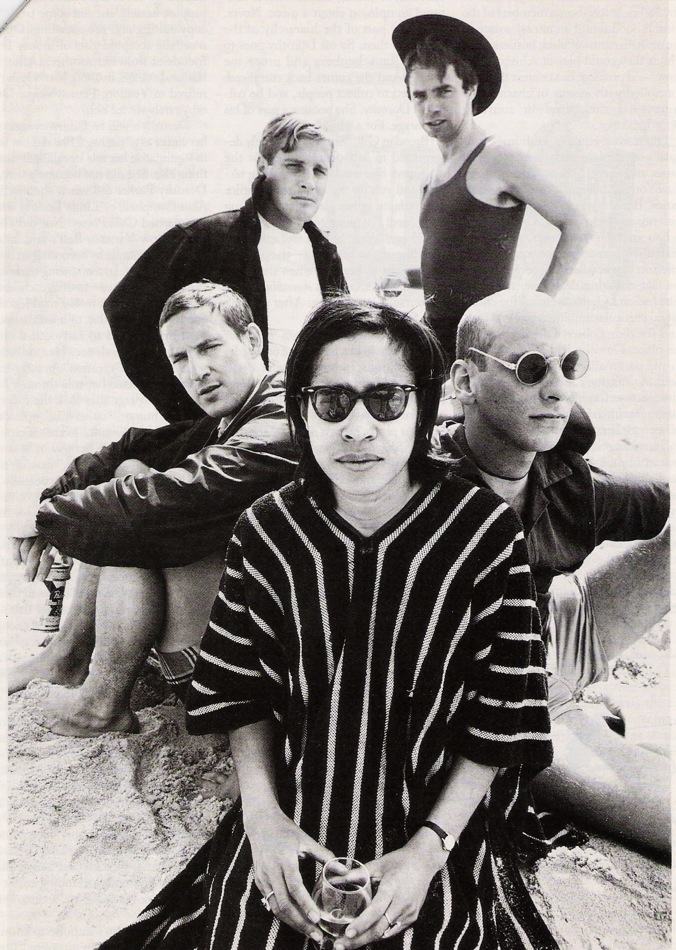
(photo: Dorothy Dean and the gang on Fire Island)
—-I began to inquire after her; but Dorothy had been on her last legs as a scenemaker, and no one I contacted seemed to know or care much about what might have happened to her. My first trip to New York after moving to California I devoted much of my time toward a search for her, but unlike Thompson in Citizen Kane I couldn’t gain a clue. I went to her apartment, but her name was not on the mailbox and no one answered when I rang the bell. A few weeks later, after I had returned to L.A., David got in touch with a seemingly reliable source, someone from Dorothy’s old Warhol days, now a successful movie publicist, who told him the following story: an extraordinary tale, but one not so far out, considering its subject was Dorothy, that it couldn’t conceivably have happened. It seems that she had attended a cocktail party at the penthouse of a well-known Broadway composer, the gathering composed of the usual witty, brittle people who congregate at such affairs; the kind of event to which Dorothy had probably been to hundreds of times. At one point in the evening, her usual two sheets to the wind, she found herself in the middle of a particularly bothersome conversation with a musician friend of the host. Finally when Dorothy could take no more, she allegedly leveled at the offending party just the sort of attack that she’d launched on hundreds of such boors in the past:
—-“You are a boring, insensitive lout who has misused and mangled the English language exactly 20 times in the last five minutes while in my presence” she said, “and if you had any feelings of regard toward the human race, you would march over to the edge of this terrace and throw yourself off.”
—-Which, according to David’s informant, is exactly what the man did, killing himself and in the process causing Dorothy to have a total nervous collapse, resulting in weeks spent in a mental hospital. Afterwards, she had gone to Boulder, Colorado, to stay in a commune run by Off-Broadway playwright, Jean-Claude Van Itallie.
—-In truth, I was to soon learn, there was not much veracity to the story (the part about Colorado, though, was accurate). Apparently an individual who happened to have been at a party with Dorothy a few days earlier, had killed himself; then somehow the two unrelated incidents had become conflated. An seemingly apocryphal tale, but Dorothy would have loved the idea of someone killing themselves over bad grammar.
—-All the years of drinking had finally caught up with Dorothy both physically and mentally. Thrown out of her longtime Morton Street apartment, she was rescued by sympathetic friends who began the process of trying to help Dorothy put her life back in order.
—-After obtaining Dorothy’s address in Boulder, I wrote her a simple chatty letter, making no reference to the recent unpleasantness. I received no reply from her. Then in February 1987, the same week that Andy Warhol died, I opened up the paper to the Death Notices to learn that Dorothy had succumbed to cancer. She had long been associated, the notice informed, with the likes of Vogue and Harper and Row and at the time of her death was a proofreader for the Boulder newspaper, The Daily Camera (what fun Dorothy would have had with inept Boulder cops and the Jon Benet Ramsey case!). Otherwise, the obituary—the only such New York Tunes unpaid obit ever accorded a mere proofreader?—was short and perfunctory and with no hint of the “real” Dorothy. Such as that—as I later learned—-after moving to Colorado she had not only joined a bible study group (!), but Alcoholics Anonymous as well. Joining AA, regardless of her sincerity or lack thereof, must have finally given her what she had been looking for all her life: complete and total command of a room full of people. Just like the old joke (one that the old Dorothy would have loved) about the comic who tells a friend he has to go to an AA meeting. His pal replies:
—-“But you’re not an alcoholic.”
—-“Yes, I know, but I need the floor time.”
To quote James McCourt in Queer Street quoting Joseph L. Mankiewicz via Bette Davis, “Slow Curtain. The End.”
*
p.s. Hey. Very happy today to restore Mr. Ehrenstein’s long dormant guest-post about the fascinating Dorothy Dean. If you want to have fun, you’ll have it. ** David Ehrenstein, And there you are! Thank you again from the future, David! Funny, I just made an upcoming Hanna Schygulla Day for the blog on Saturday. ** Sypha, Hi. ** _Black_Acrylic, Ha ha but … wait. I thought Eurovision was cancelled. Did they do a Zoom Eurovision or something. If so, no way! ** Tom K, Hi, Tom! Great to see you here! ** Bill, Hi. My weekend was all right. I watched Bruce Boone do a Zoom reading last night, so I was actually in your neighborhood in a way. Didn’t get to effedupmovies’ trove yet, but I think today. Yeah, I’ll expect to see whatever I see there while doing a shooting gallery number with pop-ups, ugh. Great about the progress with the little technical stuff! ** Thomas Moronic, Hey, T! I would imagine that your new masterpiece should be getting freed up and announce-able any day now, no? If you want to do a ‘welcome … ‘ post for it or anything just lt me know. Mark’s book is crazy great, no surprise. The Mark/Steven thing is on the other side of Paris still awaiting my grab. It’s definitely so, so much nicer being semi-reopened. It’s starting feel like a bit of normality. I hope you get your version soon, if it’s the right time, of course. Jesus. ** Damien Ark, Hi, Damien! It’s well worth the dough. Whoa, amazing progress on your novel! That’s great! I’m very careful with my novels. I only show them to one trusted person, and even then only once I think they’re completely finished, before I send them out to hopefully be published, so I totally get it. Nice that you’ve got an ideal cover artist committed. Well, ha ha, there are those who would have zero problem reading 400+ pages on that subject, but it’s true that the best seller lists might be walled-up. So sorry about your hand. Having broken both of my wrists at the same time, ouch. But I’m glad you’re feeling more you-like. Very good to see you, D., and love you too. ** Jeff J, Ace about the four tracks! Can’t wait to hear them! Yes, there’s a fantastic new Boone book from Nightboat, basically a selected/collected Bruce Boone (fiction, essays, poetry, etc.). It’s incredible, of course, and there was Zoom launch last night where Bruce read from SF. That was great. My weekend was pretty okay. Still enjoying the amount of freedom I have very much. Yours? ** Misanthrope, Hi. If you want the Steven/Mark one, you’d better order it lickety split. It’s way ltd. ed. There you go: all your LPS problems solved in one bite. Well, hundreds. Nice, the bonfire, the kids, the weekend. Sounds like a keeper. And … enjoy the grind? ** Mark Gluth, Hey, maestro! My supreme pleasure and honor! Such an incredible novel! ** Steve Erickson, Hi. Yes, that was an unexpected and happy surprise that Twilley got that late period hit. I hope you like ‘Twilley Don’t Mind’. The ‘Lost’ Twilley Band album is great if you’re a ‘Sincerely’ fan and don’t have it. Haven’t heard the new Ka yet. I did listen to a few things from the Charli XCX, and it sounds quite good, and I think I’ll go ahead and get it. The super neg stuff I’ve read about ‘Capone’ did seem very suspicious to me. I don’t how or when I’ll get a chance to see it, but I’ll take the future chance. ** Right. Dorothy Dean! David Ehrenstein! Power Couple! See you tomorrow.




 Now available in North America
Now available in North America 
woww, this was so interesting and sent me on a research journey.
Do you know there are no pictures of Arthur Lehman Loeb on line? Even more curious i believed he wasn’t in the closet, but it seems he gave the house and book store to a former model, that worked with him, for no money, doesn’t it sound like divorce agreement ?
He is a Mystery Millionaire , no articles , no social pages/gossip.
What he did to Dorothy was extra cruel, funny enough , i have a gay friend that did the exact same thing to his fruit fly, and they are both also related to a specific book store. Strange.
Merci Beaucoup, Dennis!
The “Afternoon” sequence form the original cut of “The Chelsea Girls” can be found transcribed in the giant “Chelsea Girls” book the Warhol Foundation published a fw year back. it also includes my review of the film for “Film Culture.”
Bill’s memoir “Early Plastic” can be purchased through Amazon.
Revenge being Dorothy’s favorite subject it should be noted that Woody Allen’s “A Rainy Day I New York” has become a gigantic international hit. SUCKIT UP SATCHEL!
Michel Piccoli R.I.P.
@ David, I greatly enjoyed your account of Ms Dean’s life and times. Plus I’ve long been a sucker for any Factory tittle tattle.
You’re right that Saturday’s Eurovision broadcast was not the actual contest, just a run-through of all 41 songs in a “non-competitive format”. I did briefly check the comments on Twitter, and folk were still enjoying it. Doubt there was anything to top last year’s Hatari brilliance, mind you.
Nice to this day again – thanks, David E!
Dennis – thanks for the offer – yeah I’ll start thinking about a welcome post for my book. Thank you! As to when it’ll be out – it’s still stuck at the printers in Washington state. So it’s there until they ease the lockdown and from what I can tell and from what Philip has said, they seem to have been a bit more cautious than some of the other states. Hopefully it won’t be stuck in limbo for too much longer!
Here’s a link to urchasing the “Chelsea Girls” book No cheap but if you love Warhol worth every penny.
And here’s a link to buying “Early Plastic” (a steal at $6.97)
Dennis, Another great restore!
Eh, the grind ain’t so bad. Better than having no grind, which would mean no job and no paycheck. I’ll take it. Plus, there’s no commute now and I’m loving that. 😀
Currently reading Harold Brodkey’s Profane Friendship. Hmm…a little different than what I expected, more…lyrical? But not the worst thing I’ve ever read. Some of it I really like. Some things are bugging me. It does make me want to go to Venice. And be 14 again and fall in love with a boy who’s a whore. 😉
There’s a pile-on against CAPONE when it’s actually a film with a lot of strength. I can understand why some people would just find it a wallow in ugliness, but it also strikes me as suffering from being perceived as “Josh Trank’s failed comeback film.” I don’t care about that, but I don’t think looking at it in that light benefits the film, except that he went to tonal and emotional extremes he was barred from THE FANTASTIC FOUR.
I watched DRESSED TO KILL again and wrote a rough draft of my essay for the Quietus. It’s beautifully directed and layered with subtext, but I can’t get past the way it stomps on real transgender people and their identity (far more specifically than its inspiration PSYCHO) for a plot twist.
It’s Don Bachardy’s Birthday